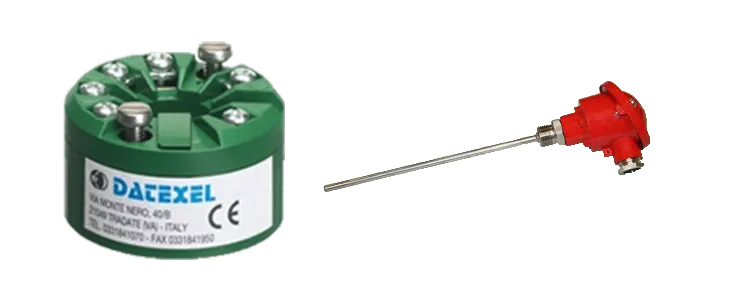The Difference Between Temperature Transmitters vs. Sensors


Unsure of the difference between temperature transmitters and sensors? This post breaks it down for you by explaining the benefits of each and how they work.
You need to know the difference between temperature transmitters and sensors to get accurate readings of the temperature in your system. Both devices measure the temperature, but they do so in different ways. So what are the differences between temperature transmitters and sensors?
There are many sensors, but the three main types for industrial measurement and control are thermocouples, resistance temperature detectors, and thermistors.
The most common temperature sensor is the thermocouple. It consists of two dissimilar metal wires fused at one end. If the fused wires are at a different temperature than the other end of the cable, there will be a small flow of electrical current.
You can attach thermocouples to vessels or insert them into vessels or pipelines with metal sheaths. They can measure temperatures up to 1850°C. Across a resistor, you can measure a very small voltage in the mV range.
A thermocouple transmitter can process controllers with a compensating cable, but this cable is expensive and not always readily available.
An RTD is a resistance temperature detector, mostly made from platinum and now manufactured from nickel. The Pt100 is the most common RTD used in industrial measurement and control.
The Pt100 is a two-wire device, and the resistance changes with a temperature change. At 0°C, the resistance is 100 Ohms, and at 100°C, the resistance is 138.5 Ohms. A third wire can compensate for the resistance in the wire, like a 1 or 2 Ohm resistance change in the cable can amount to an error of 5–6°C.
So three-wire RTDs are the most common type used. RTDs can also be attached to vessels or inserted into vessels or pipelines with metal sheaths, but the maximum temperature range is 850°C.
An RTDs connection can process controllers with the aid of two core overall screened cables, but any change in resistance in this cable can result in inaccuracy.
Thermistors are generally used to monitor equipment temperatures, such as motors or compressors, compared to RTD and thermocouples, which are typically used in process conditions.
Thermistors are cheap, and the manufacturing process is like an RTD, but the resistance is much higher in 10K. They are not as accurate as thermocouples or RTDs, but the general use is motor or compressor protection. If the temperature goes high on a motor, the resistance needs to go high impedance, which makes it easier to spot a runaway temperature problem.
With the resistance-temperature curve not being linear, it is difficult to be as accurate. Also, there are thousands of thermistors with different curves, making it challenging to design a temperature transmitter that is suitable.
Thermistors are typically in the motor windings or compressors assemblies. You can connect them to process controllers with a standard cable, but they are generally not accurate enough for fine process control.
A temperature transmitter measures the mV or resistance from the temperature sensor. The temperature transmitter linearizes this signal and then converts it to a 4–20mA output.
All temperature transmitters are, by design, two-wire loops, meaning the power supply and the output are on the same two wires. These two wires can transmit the 4–20 mA signal thousands of feet or a couple of miles.
You can further increase this range with signal boosters for a few bucks more. The transmitter can be a head mount transmitter fitting into a thermocouple head, an RTD head, or a DIN rail mount.
Today, these transmitters are usually smart, so you can configure them for virtually any input. You can enhance temperature transmitters by isolating them so that the input and output are galvanically isolated. This isolation is a must on high-temperature installation when thermocouple insulation breaks down.
Understanding these differences between temperature transmitters and sensors is critical for any process engineer. If you are using thermocouples, RTDs, or thermistors, play it safe and incorporate a temperature transmitter into your design. It can save you from costly mistakes, but it will also give you much more flexibility and accuracy in your process.
Datexel has been designing and manufacturing temperature transmitters that work well in various applications.
Don’t hesitate to contact us today for more information on temperature transmitters and their uses in your application.